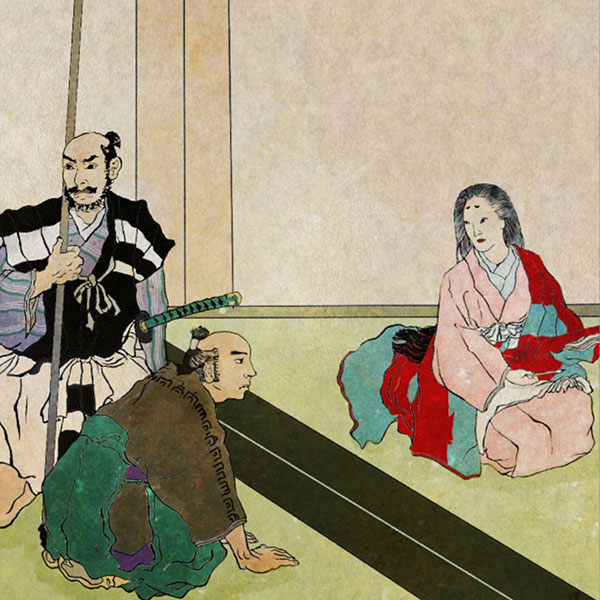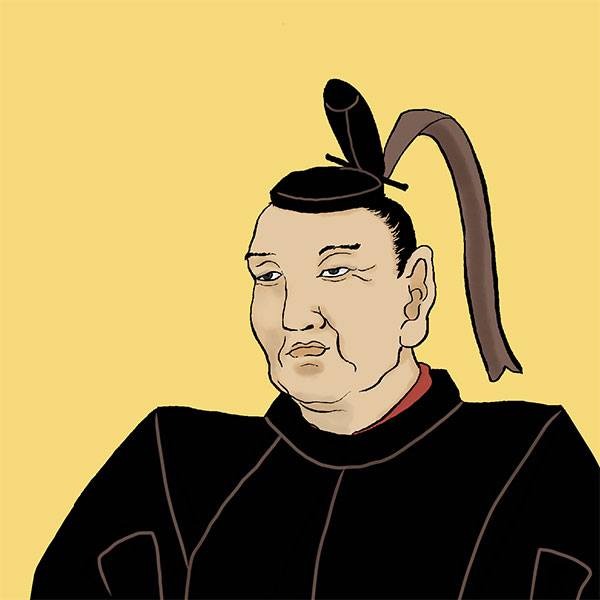Battle of Tanabe Castle (1/2)Does education help you? The genius of Yusai Hosokawa

Battle of Tanabe Castle
- Article category
- case file
- Incident name
- Battle of Tanabe Castle (1600)
- place
- Kyoto
- Related castles, temples and shrines

Tanabe Castle
- people involved
In July 1600, a battle took place at Tango Tanabe Castle (Maizuru City, Kyoto Prefecture) as a prelude to the Battle of Sekigahara. In this battle, known as the ``Battle of Tanabe Castle,'' Yusai Hosokawa (Fujitaka Hosokawa) of the eastern army was besieged with 500 men against the 15,000 men of the western army. The battle was at an overwhelming disadvantage for the Hosokawa side, but Yusai, who was known as the most cultural figure of his time, moved the Emperor, and although he was defeated by the Western army, Yusai escaped safely. Keeping 15,000 soldiers at Tanabe Castle had a major impact on the main battle at Sekigahara. This time, I will explain the Battle of Tanabe Castle in an easy-to-understand manner.
What is the Battle of Sekigahara?
Before going into the explanation of the Battle of Tanabe Castle, I would like to briefly explain the Battle of Sekigahara. After Toyotomi Hideyoshi, who was next in charge of the government after Oda Nobunaga, died in 1598, the 6-year-old Toyotomi Hideyori succeeded him. For this reason, the actual administration of government was a council system of vassals of the Toyotomi family and influential daimyo, and was carried out by the ``Five Elders and Five Magistrates.''
The five ``Five Elders'' who decided on important political matters were Ieyasu Tokugawa, Terumoto Mori, Toshiie Maeda (after Toshiie's death, his son Toshinaga), Hideie Ukita, and Kagekatsu Uesugi. On the other hand, the five magistrates in charge of practical affairs were Mitsunari Ishida, Nagamasa Asano, Masaie Nagatsuka, Geni Maeda, and Nagamori Masuda, and they were in charge of administration, justice, finance, religion, and civil engineering, respectively.
In the Toyotomi administration, there was a conflict between the military-related military-related factions such as Kato Kiyomasa and Fukushima Masanori, and the literary factions such as Ishida Mitsunari, who were in charge of political affairs. Tokugawa Ieyasu began marrying feudal lords without permission, which had been prohibited, and became related to the Mudan faction one after another, increasing his power. Mitsunari Ishida was up against it. After Toshiie Maeda, who had played the role of arbitrator between the two factions, died, Ieyasu assumed power and the conflict between the two factions became even more intense.
Furthermore, Ieyasu went against Hideyoshi's will and moved to Nishinomaru in Osaka without permission. He began to arbitrarily increase the number of feudal lords and transfer fiefdoms. Furthermore, Kagekatsu Uesugi, who had 1.2 million koku in Aizu, was suspected of rebellion, and the Uesugi Conquest (Aizu Conquest) was carried out.
Mitsunari, on the other hand, raised an army to overthrow Ieyasu and protect the Toyotomi clan's government. He formed an anti-Ieyasu coalition under the banner of Mori Terumoto, one of the five chief elders who opposed Ieyasu, and organized a western army, which departed from Osaka Castle and attacked Fushimi Castle on July 19th (Battle of Fushimi Castle). Furthermore, they invaded Mino Province (Gifu Prefecture) and Ise Province (Mie Prefecture).
Upon receiving this, Ieyasu took it back from the Uesugi expedition, stayed at Edo Castle for a while, and then headed west. Then, on September 15th, the Eastern and Western armies clashed at Sekigahara (Sekigahara Town, Gifu Prefecture). After a six-hour battle, the eastern army was victorious.
Battle of Tanabe Castle ① Who is the key person, Yusai Hosokawa?
The Battle of Tanabe Castle, which could be considered a prelude to the Battle of Sekigahara, took place from July 19th to September 13th in the 5th year of Keicho. Yusai Hosokawa protects Tanabe Castle. After serving the shoguns Yoshiteru Ashikaga and Yoshiaki, he worked as a feudal lord with 110,000 koku of Tango land under Nobunaga Oda. He is also known as an ally of Mitsuhide Akechi, and his eldest son, Tadaoki, is married to Mitsuhide's daughter, Tama (Garasha).
However, after the Honnoji Incident, Yusai did not take Mitsuhide's side, imprisoning Tama, driving back Mitsuhide's messengers, and in order to mourn Nobunaga, he shaved his head, became a priest, and retired to Tanabe Castle. At this time, he handed over the headship of the family to his son Tadaoki and took the pseudonym ``Yusai.'' This response was successful, and even after the Honnoji Incident, he served Toyotomi Hideyoshi without being punished, and at the Battle of Sekigahara, he sided with Tokugawa Ieyasu's eastern army, successfully continuing to ride the trends of the times.
Yusai was also known as one of the most cultural figures of his time, mastering waka poetry, renga poetry, the tea ceremony, and kemari, and was also said to have a deep knowledge of Noh theater and the game of Go. Furthermore, he learned swordsmanship from the master swordsman Bokuden Tsukahara, and in addition to being certified in the Heki style of archery, he also received the stamp in the ``Takeda style,'' which combined archery, horsemanship, and etiquette, making him a man of both literary and martial arts.
Of particular note is the fact that he received the Kokindenju (the interpretation of the Kokin Wakashu, etc., passed down orally as a secret), which has been passed down to the Sanjonishi family, from Kimie Sanjonishi. Originally, it should have been passed down within the Sanjonishi family, but since Kimie's son was still young, he passed it on to him on the condition that he ``never pass it on to anyone else, and if the Sanjonishi family becomes extinct, he will responsibly pass it on.'' Masu. This would have a major impact on the battle of Tanabe Castle.
Battle of Tanabe Castle ② The Hosokawa clan joined the eastern army
After Yusai Hosokawa retired, his successor Tadaoki Hosokawa was active under Toyotomi Hideyoshi, participating in the Battle of Komaki Nagakute, the Kyushu Conquest, the Odawara Conquest, and the Bunroku War. Tadaoki was faced with a crisis when Toyotomi Hidetsugu's seppuku incident occurred in 1595. Hidetsugu succeeded Hideyoshi and became Kanpaku in 1591, but suddenly he was suspected of rebellion. Furthermore, Hidetsugu committed seppuku after becoming a monk on Mt. Koya, and his concubines and children were beheaded as a result of his involvement.
In fact, Tadaoki owed Hidetsugu 200 pieces of gold and also married his daughter to Maeno Kagetada, who served Hidetsugu. For this reason, he came under suspicion from Hideyoshi and Mitsunari Ishida, who believed in Hideyoshi's intentions during the seppuku incident.
At that time, it was Ieyasu Tokugawa who helped Tadaoki and successfully interceded, and it is said that it was Ieyasu who arranged for Kaneko. As a result, Tadaoki deepened his friendship with Ieyasu and came into conflict with Mitsunari. Tadaoki also participated in the Ishida Mitsunari attack that occurred in Leap March of 1599, following the death of Maeda Toshiie. Against this background, the Hosokawa clan participated in Ieyasu's subjugation of Uesugi, and quickly joined Ieyasu's eastern army during the Battle of Sekigahara.
At this time, Yusai was at Miyazu Castle (Miyazu Castle, Kyoto Prefecture), and his wife Tama was in Osaka. Since Mitsunari's father and wife were within his sphere of influence, the feudal lords who were patronizing Toyotomi were closely watching what Tadaoki would do, and it is said that Tadaoki's joining Ieyasu had an influence on other feudal lords.
By the way, his wife Tama met a gruesome end at this time. The night before Mitsunari's military launch, Tama was at the Hosokawa residence in Osaka, but when Mitsunari attacked and tried to take him hostage, he decided to give up his life. Tama, who had converted to Christianity and had the baptismal name ``Garasha'', died by the intervention of Hidekiyo Ogasawara, the chief retainer, because suicide was forbidden by Christianity. Hidekiyo committed suicide by setting his mansion on fire.
Battle of Tanabe Castle ③ Start of siege battle
Ishida Mitsunari, who raised an army against Tokugawa Ieyasu, first attacked castles in order to subjugate the military commanders who were on Ieyasu's side in the Kinki region. One of these was Tanabe Castle, which was protected by Yusai Hosokawa, and 15,000 soldiers surrounded the castle, including Shigetsugu Onogi, the lord of Fukuchiyama Castle, who was on the western side, and Shigekatsu Maeda, the son of Maeda Geni, one of the five magistrates, and the lord of Kameoka Castle. Did. Yusai, on the other hand, was at Miyazu Castle until July 17th, but when he was informed that Takakazu Mitotani had become one of Mitsunari's agents and entered a mansion in the castle town, he immediately left Miyazu Castle. After burning it down, they returned to Tanabe Castle by boat, gathered arms and ammunition there, and prepared to siege the castle.
Meanwhile, Takakazu Mitotani joined Tanabe Castle. In fact, Takakazu had decided to join Yusai instead of Mitsunari, considering his late father's will to "obey Ieyasu" and his relationship with Yusai! With Takakazu joining, Yusai and his son Yukitaka Hosokawa, nephew Mitsuyuki Mibuchi, and 500 other people imprisoned themselves in Tanabe Castle. Among these 500 people were people related to the temple, farmers, and townspeople. Furthermore, it is said that Yusai's legal wife, Musuka Numata, also wore armor and fought alongside her husband, and it appears that the Hosokawa clan and the people of the territory were engaged in an all-out war.
Then, on July 19th, the western army finally began its attack on Tanabe Castle. The Battle of Fushimi Castle was taking place at the same time. The main force of the Eastern Army was in Edo, and at this time Tadaoki Hosokawa was near Utsunomiya. No reinforcements are expected for Tanabe Castle.
However, the western army was unable to attack Tanabe Castle. The reason is said to be that the military commanders who had studied under Yusai, who was a man of culture, were in the Western Army and were reluctant to attack their master. A gunfight ensued, and one theory says that some military commanders fired blank guns without loading bullets, and took the position of attacking.
Battle of Tanabe Castle ④Emperor orders to protect “Kokin transmission”!
Meanwhile, the Imperial Court begins to move to help Yusai Hosokawa. This was because they were afraid that Kokin transmission would be discontinued due to Yusai's death. In fact, in March 1600, before the Battle of Sekigahara, Yusai began passing on the Kokin transmission to one of his disciples, Prince Hachijonomiya Tomohito, brother of Emperor Goyozei. However, just before the Battle of Sekigahara, on May 29th, he stopped Kokindenju and returned to Tango (Maizuru City) in the name of preparing for the battle.
The article on the Battle of Tanabe Castle continues.
- people involved

- WriterNaoko Kurimoto(Writer)I am a former travel industry magazine reporter. I have loved history, both Japanese and world history, since I was a child. I usually enjoy visiting temples and shrines, especially shrines, and often do ``pilgrimages to sacred places'' themed around historical figures. My favorite military commander is Ishida Mitsunari, my favorite castle is Kumamoto Castle, and my favorite castle ruins is Hagi Castle. My heart flutters when I see the ruins of battle castles and the stone walls of castle ruins.




